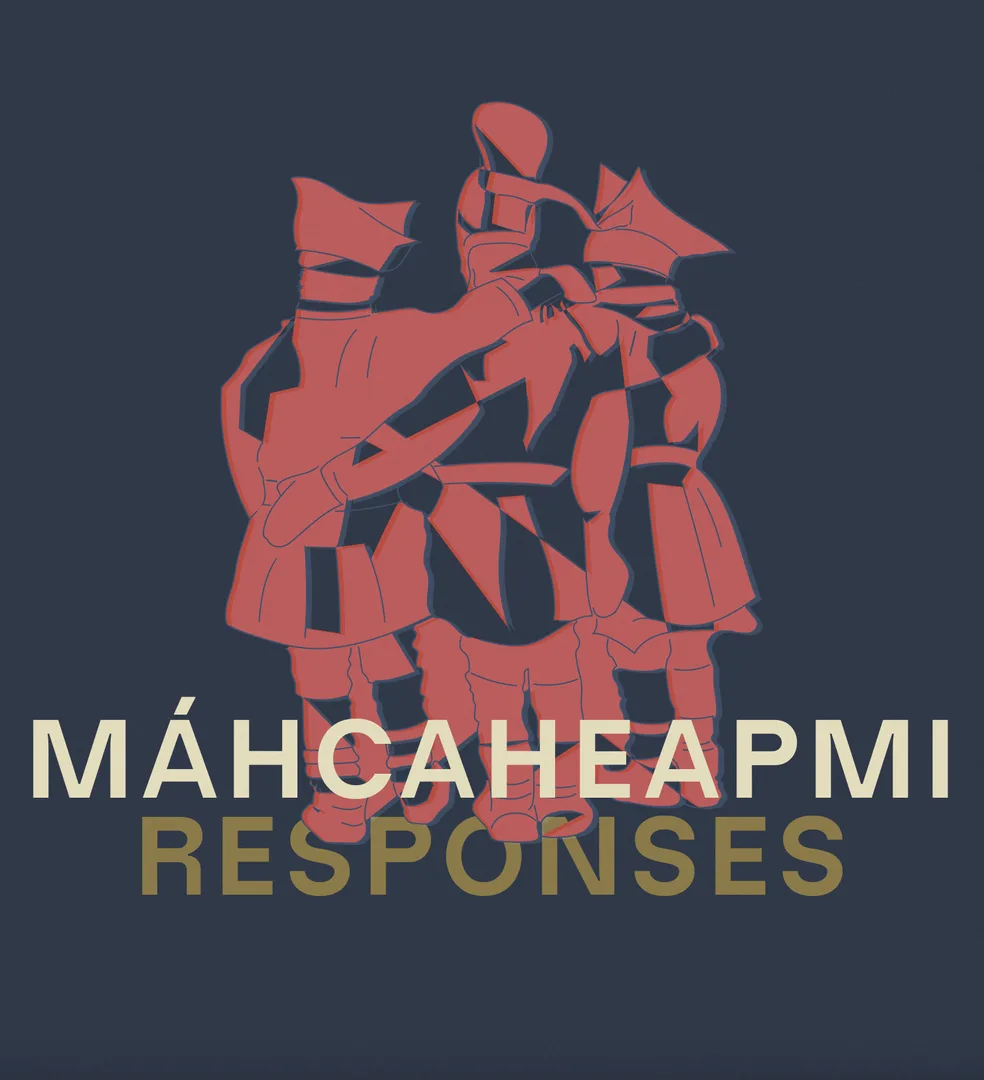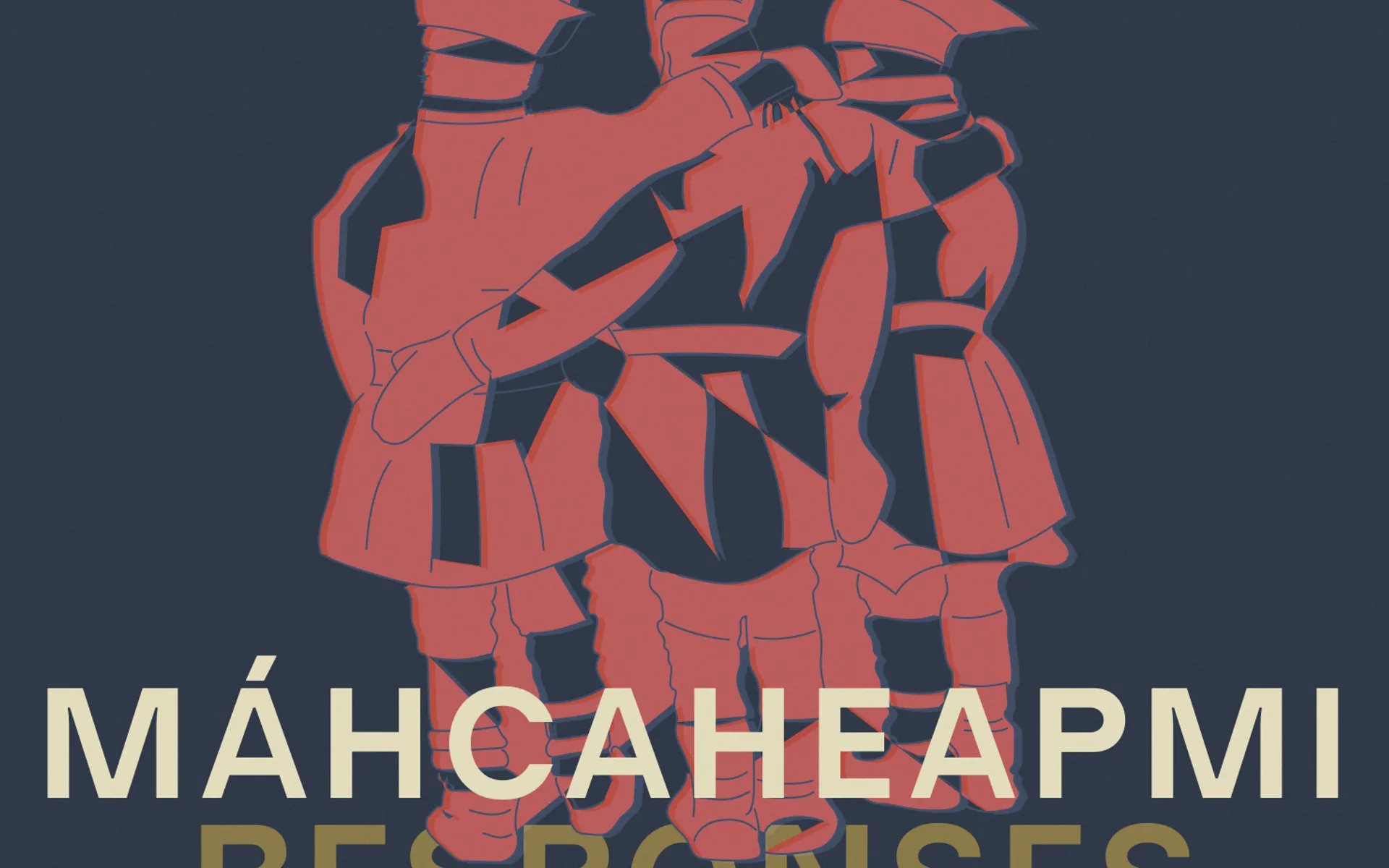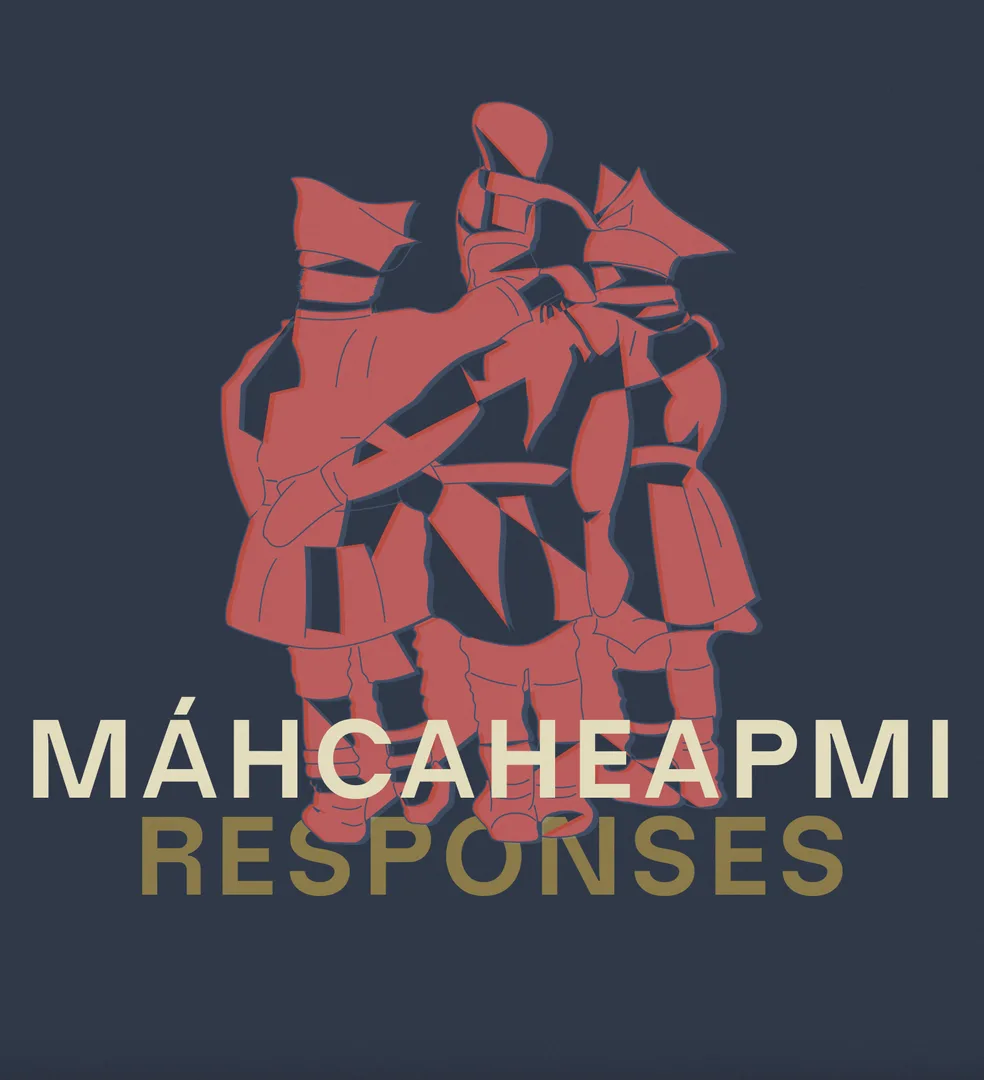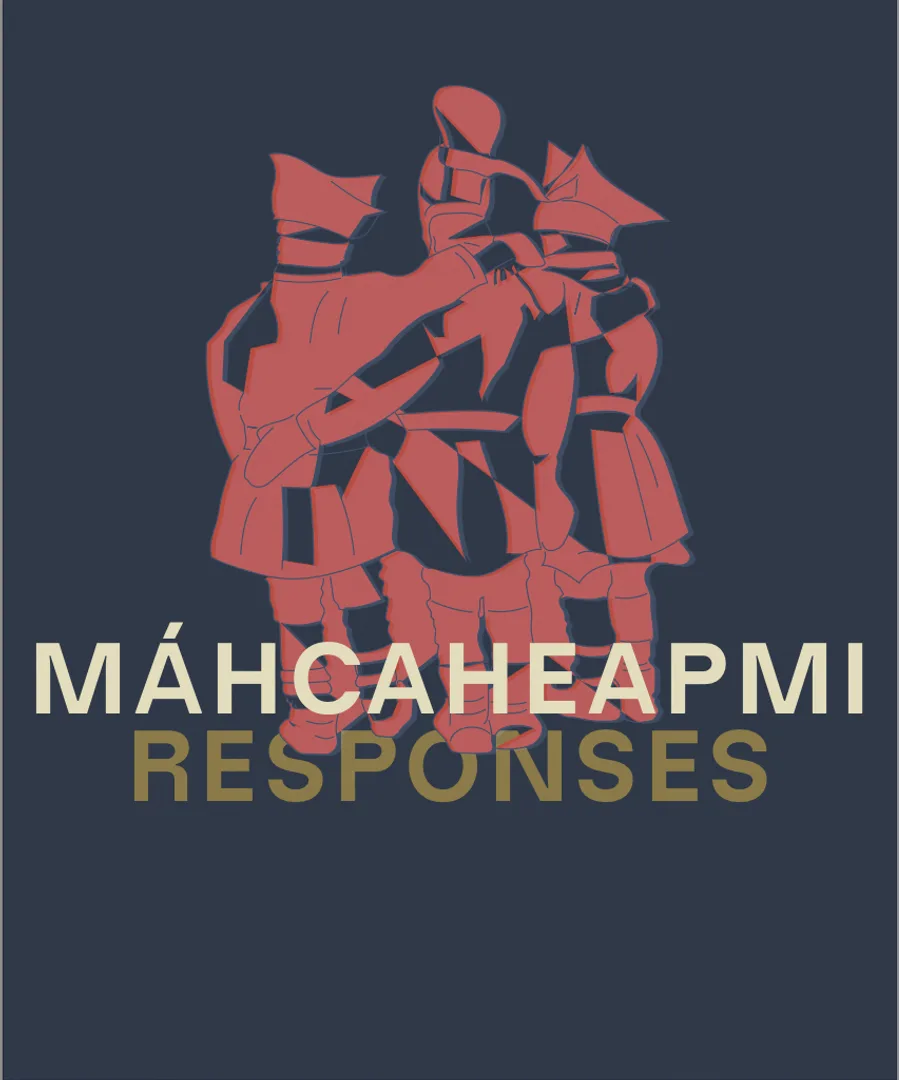

Máhcaheapmi (Responses) #1: Colectivo Cherani
The artist group Colectivo Cherani were central to the first iteration of the Máhcaheapmi (Responses) project, hosting the Sámi delegation for their residency on P'urhepecha lands in Mexico.
Below you can read extracts from an introduction to Colectivo Cherani’s work and an interview with the group, both by curator Cuauhtémoc Medina.
All these texts were originally published in Spanish in the catalogue for the exhibition Uinapikua at Museo Universitatio Art Contemporáneo (MUAC) in Mexico City in 2022. Translations from Spanish by Neil Fawle.

Uinapikua. Colectivo Cherani. Installation view. Museo Universitario Arte Contemporáneo, MUAC/UNAM, 2021. Photo: Oliver Santana
Introduction to Colectivo Cherani
Colectivo Cherani is made up of Ariel Pañeda, Francisco Huaroco, Bethel Cucué, Alain Silva Guardian and Giovanni Fabián, five Indigenous visual artists from the autonomous community of Cherán K’eri in Michoacán.
The artists’ practice is directly linked to their community’s cultural processes, uses, customs and traditions, and through different techniques and disciplines — easel painting, mural painting, photography, in-situ installations, and others — they are able to reflect this multiplicity in their artistic output. By the same token, the relationship they have with their territory and nature feeds into their work socially, naturally and symbolically.
From the diversity of religious, artistic, historical and ancestral expression, the collective retrieves traditional techniques and art-making to reinvent, question and discover its reality from artistic interpretation. Further, its practice does not seek to be part of the global world’s parameters and systems. Rather, it positions itself as an expression that arises from its members being and acknowledging themselves as P'urhepecha.
Colectivo Cherani: Autonomy from a Multiple Perspective
By Cuauhtémoc Medina
Over more than a decade ago, on 15 April 2011, the P'urhepecha community of Cherán made the decision to rise up against the violent threat of looting by loggers in collusion with organised crime and political corruption. The lack of security the Mexican State failed to shore up for many of the country’s communities — exploited financially and harassed daily — led to an eruption of rage. After the community’s women stopped the loggers’ trucks from passing, the community decided to sever all ties with the local and federal government and with the political party system, thereby forming a self-government and entrusting the creation of living conditions to its own community. At the same time, the autonomy of Cherán is symptomatic of a failed national state model and a glimpse into the construction of another power. Not a programmatic search but one carried out within the details of practising another social contract.
The Cherán uprising has engendered not only an exemplary experiment in community sovereignty, but also a field of cultivation for the rebirth of P'urhepecha identity and an unprecedented commitment to articulating artistic practices with community life. Since the time of the rebellion, a nucleus of creatives from different generations — chiefly working in the practice of painting — have embraced the challenge of creating multi-dimensional artistic support. Residents in the workshops of Cherán’s Casa de Cultura, these artists progressively integrated their work into reconstituting the life of the town, and with the remains of the trucks destroyed in the 2011 uprising, the collective made a monument embedded in the natural surroundings: a sculptural park inside the community forests in memory of the rebellion. Secondly, the group has realised a collaborative endeavour in public art: each year they invite artists, both Mexican and international, to decorate the walls of the town and thus, the fences and walls are transformed into a space of dreams and utopias, marking the territory of a new subjectivity. Sheltered under the Colectivo Cherani name, the collective’s members have worked to produce an array of painted, sculpted and assembled pieces which, despite being projected from the individuality of each piece, aspire to illuminate the history, imaginary, desires and possibilities of a sociability that is by turns ancient and unprecedented.
Some of these works are intended as a direct accompaniment — as backdrop, décor, allegorical continent — to acts in political and social life: collective celebrations, constituent political events and acts of memory. In these multiple aspects, Colectivo Cherani has taken on one of the most complex of artistic tasks: weaving a common experience into personal work, renegotiating relations between different modalities of tradition and contemporaneity and reinventing identity from poetic freedom. In the first quarter of the twenty-first century, these practices represent one of the biggest lived experiences with respect to artistic social agency. An art which, among its greatest virtues, undertakes the role of supporting the community revolution, yet without seeking a universal and definitive model. Conversely, its approach strives for the feat of bringing about a lived experience of freedom and political astuteness, recreating the ancient P'urhepecha nation in images as it takes a stance in relation to eventuality.
[…]
At a time in which official politics and mythologies of opposition in the artistic field draw from the term community to put forward a utopian horizon, bearing witness to the effective artistic operation of Colectivo Cherani becomes an antidote. Its specific nature sets forth a political, artistic and spiritual reading to us: this is not art of community simulation, based on a false, archaic certitude that would have been forced into the system’s culture policy; nor does it contain traces of the illusions that nestle into the conjecture of “political art”.
Rather, in its constant negotiation between tradition and translation, in its political articulation to weave a future, a past, an experience, the work of Colectivo Cherani raises a challenge that is at once artistic and ethical. Its multiplicity, the complexity of its figurative and material negotiations and its diverse and multiple concept of identity invite us to exercise a different form of cosmopolitanism, made from the willingness to experiment with that which is alien and accept provisionality as the necessary space of all learning.
Broad, Profound, Ancient Roots:
An Interview with Colectivo Cherani by Cuauhtémoc Medina
Cuauhtémoc Medina (CM): On 15 April 2011, life inCherán changed through the union between the community and the uprising. After that year, your art-making began to gestate collectively. How did the movement in Cherán influence your work?
Colectivo Cherani (CC): The movement of struggle and resistance which united people in the community who were seeking security, justice and the reconstruction of their territory forced us to question our actions and work across the board, including in our art-making. Although it had surfaced in a broad, ascending process, like a profession and way of life, everything was suspended through the need to fulfil commissions and activities to maintain the cantonment and communal struggle. There were activities carried out in a team, beyond any prestige in the cultural sphere. The relationship and interaction with neighbours and community members, without seeing distinctions of any kind, with everyone on the same level, denoted a general distancing and even an unfamiliarity with values, with the reason behind uses and customs, of being Cherani. Hence the urgent need to go back to these practices, including collectiveness, as a way to advance towards commonality.
As visual artists, our concern within these circumstances became a need to show, rescue and maintain the living memory of a people, making ourselves reflect with awareness, turning towards the inside of the P'urhepecha cultural cosmos and knowingly harness it to display and share it by way of a renewed process of individual, collective and communal visual production.
CM: Ten years on from the uprising in Cherán, could you talk a little about your experience of that change of paradigm, first from the sociopolitical plane and then from the cultural and artistic one?
CC: We are strongly influenced by the territory, beyond its boundaries: the dense pine, oak and fir-tree forests. We are inspired by its geography, by being surrounded by hills and cliffs; by the wind, the cold, textures, smells, colours, flavours, the flora and fauna; the social territory, our ancestors and their enigmas, local and cultural history, social relations, parties, family, food, stoves; the spiritual territory, sacred and prohibited places, animals and plants — those that heal and those that kill. The fact of being Indigenous, of being part of a constant, transcendental energy from territories that make us common, communards and community.
Collective work is carried out by distributing activities with the idea of obtaining a good result with the work in question, yet the community-based creative process also means including that unknown part of the activity, but with a will to collaborate, learn and, consequently, understand, and then to share. Therefore, from a simple talk with a tata k’eri (grandfather) comes great knowledge that contributes to art-making.
If there is one thing that has contributed to and strengthened recent history then it is the sense of community, particularly in younger generations. This feeling can be noted in art work and creates a sense of belonging.
CM: Your works are inspired by the events you have experienced, from the essence of community. What do you understand by community? How was the process of creating collectively? And what is the relationship with community decisions?
CC: Ten years on from the struggle and the demand for the right – recognised inside the international legal framework – to the free will of Indigenous people, as well as the lamentable actions of the political parties now left behind, our administrative organisations have been chosen through assemblies on the basis of uses and customs. These are governed by a senior council and an operations council. Yet the struggle also entails changes in different respects, including values, appreciation, culture and art. Therefore, the sense of belonging, which was gradually consolidated in concert with collaborative work, gave rise to a faster and more inclusive advancement in the “art movement”, which includes and prioritises collective community work, beyond the individual.
An example of this lies in the production of murals which support, strengthen, raise awareness of, contribute to and even question “community revolution”. Murals made in collaboration with amateur residents, local artists and overseas artists willing to contribute with a social service for the community. Furthermore, in terms of the tasks and work carried out from and since the “movement”, they show inwardly and outwardly the life values that give meaning to the existence and spirituality of the Cherán inhabitant.
CM: The current world has been built from a colonial and Eurocentric perspective which is transferred over to the artistic plane. Do you feel your work somehow escapes that hegemony? And does it even have foundations in European pictorial representation?
CC: Although our visual work displayed characteristic elements of Cherán or the P'urhepechas, prior to 2011 we felt that for our people having artists with academic training who forged work from that was an achievement; that knowledge of artistic currents and being immersed in contemporary creative processes through “art history”. Being influenced is a constant that is inescapable, yet what is imperative is that in a given moment (or many) in our individual trajectory — and from events such as the one in Cherán — we have been able to reflect on the modes of conceiving, creating and presenting this output. In our case, we are willing to work in a community, to unreservedly contribute with our capacity and knowledge, to relinquish individual endeavours when there is a better option to gain a better result. We are in a process of “unlearning”, of drawing on our broad and profound roots to put forward an art from where and who we are, but mindful that we cannot shut ourselves away from interculturalism and multiculturalism or technological advances and other external situations.
CM: Community values, identity,language and belonging are currently in a state of crisis for different reasons: the overexploitation of natural resources, migration, violence inflicted by organised crime, the conflict of boundaries between communities, globalisation, environmental crises and, on top of that, a pandemic. In what way does your approach enter into the discussion of these issues?
CC: Everything is subject to cause and effect, in such a way that if you only present the folklore of your community or the culture you belong to in your work, as “beautiful” as it may be, it would be incomplete, partial, because there is a lack of meaning. Where does it stem from? What does it question? We, as people of the forest, usually give the example of a tree: as big as it seems, it has been moulded over time by the elements and beings living in it; what feeds it, makes it strong and gives it character is that which we don’t see: the broad, profound, ancient roots. The collective’s work is not only present by proposing and questioning its environment, to the extent that some murals have been erased for different reasons. Other sectors of the community are becoming increasingly more involved because the impact the images have goes beyond the narrowed ideas of what it means to be P'urhepecha. Our work projects a more authentic reality, despite not joining ideas at certain times, and we have reached out to other communities, both P'urhepecha and in the rest of the country and abroad.
As a community, Cherán is like many others and is not impermeable to cultural, political and external social influences, or natural factors, climate, disease and pandemics (such as COVID-19 right now). Likewise, our geographical location, our dynamics, influences as a model the peoples of the region, who take Cherán as a reference point for their mode of organising and recovering their territory.
CM: Your works are a form of memory of and homage to P'urhepecha culture. Can you explain how the iconographic elements from your culture operate in your new work, Uinapikua?
CC: Living memory is an element of consciousness that makes us act with awareness. One example are the trucks used, at that time, for the unlawful looting of the forest. In an outburst of justice, they were burned by the community members, both female and male. And so local artists, aided by the authorities, later placed them between the trees in the forest in the form of a plastic intervention and as an offering to the earth. Since then, a generational dialogue has been created in the community and with people visiting the space, and also concerning the schism that was experienced and has become part of our recent history.
Cherán’s cultural life is ancient. In Uinapikua we encounter elements that date back to different times: language, the pre-Hispanic and that genealogical tree, the pine tree, the foundation of the wooden men (or the settlers of Cherán) and the granary and its relationship to home and family. The new piece includes elements such as tejamanil (wood used for roofing), strips of colours, different skins, embroidery, masks, resin, and so on; paraphernalia that attempts to explain existential, individual and community doubts and certainties from the P'urhepecha cosmos, before arriving at the events of the Mexican homeland and its participants, questioned from communal creative strength by the artists: Uinapikua.
CM: In Uinapikua, there are five proposals displayed which work as one sole proposal as the stretchers overlap. The proposals are diversified and give rise to different visual games, according to connection and lighting. Is this the first time you’ve created a work that can shape different readings, depending on its position? How did the idea come about and what was the process?
CC: Part of the collective’s work involves giving over some of their individuality in the interests of a better result or, alternatively, to achieve a set purpose. The lack of spaces for exhibition, installation or intervention, the lack of a cultural infrastructure or even one of understanding, a lack of appreciation for the aesthetic, discursive and material value of the artwork — be it mural painting, easel painting, sculpture, installation, etc. — forced us to search for modes of production, presentation and even transport to reach different spectators. A search which has also led us to find solutions to ensure the continuance of a work, which, in turn, translates into an aesthetic possibility upon attaining other ways of presenting the same piece with different — and even divergent — results. The contribution of different ways of seeing the subject matter reiterates how P'urhepecha culture draws from the vision of each artist, leading us to encounter organic communication in Uinapikua. The idea is to present five proposals which work as a whole in one space as the modules comprising the work enable them to be “played” with, encompass the setting of the place, and limit or strengthen capacities to see the collective result, the aesthetic achieved and its conceptual reading.
CM: Could you expand upon the concept of Uinapikua? This term from the P'urhepecha language to describe the word “strength”, understood as a permanent creative energy, of language related to a nature that transcends…
CC: Living in a community that has undergone multiple changes entails the diversification of media and the environment surrounding us: we progressively adapt external ways of doing and living. The strength that stems from people uniting over attacks on their ways of life gives a voice to community resistance and awareness; namely, JuchariUinapikua, “our strength”. It involves consigning the individual voice to the amalgamation of the collective shout until the irrepressible community force is achieved. Uinapikua is the individual strength of five proposals that arise from Juchari Mintsita, “our heart”. It is believing in something, thinking about it and making it move through a plastic process.
CM: To conclude: For you, what does the change of exhibition space entail? Moving from the public and community space of Cherán to a university museum.
CC: As Indigenous artists from an Indigenous people we face challenges that we slowly resolve through work and with some difficulty, yet always with strength and perseverance. From moving forwards in this profession, and with no background in it, forging a path in a difficult art world and profession and managing to gain the acceptance of diverse spectators, to reaching collaborations that are collective and community-based, whether that be with fellow artists started out or those with an established career. The recognition of our work has enabled us to be a voice for the evolution of our community, for our culture and for our aesthetic proposals on a local, state and even national and international level.
Presenting Uinapikua at the UNAM Museo de Arte Contemporáneo is a huge milestone for us in our careers. Moreover, it shows the paradox of speaking from the community to arrive at such a specialised place. From here, we hope to reach Indigenous peoples from other latitudes, as well as fellow artists and the general public.

